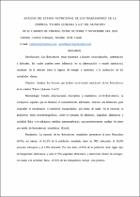Please use this identifier to cite or link to this item:
https://repositorio.uco.edu.co/jspui/handle/20.500.13064/964Full metadata record
| DC Field | Value | Language |
|---|---|---|
| dc.rights.license | http://creativecommons.org/licenses/by/3.0/ | - |
| dc.contributor.advisor | Quinto-Cumplido, Adriana María | spa |
| dc.contributor.author | Cardona-Velasquez, Valentina | spa |
| dc.contributor.author | Arcila-Cataño, Jackeline | spa |
| dc.coverage.spatial | Sudamérica, Colombia, Rionegro, Antioquia | es_ES |
| dc.date | 2020-11-11 | - |
| dc.date.accessioned | 2021-08-25T14:10:25Z | - |
| dc.date.available | 2021-08-17 | - |
| dc.date.available | 2021-08-25T14:10:25Z | - |
| dc.date.issued | 2020-11-11 | - |
| dc.identifier.uri | https://repositorio.uco.edu.co/handle/20.500.13064/964 | |
| dc.description.abstract | Introducción: Los floricultores están expuestos a factores socioculturales, ambientales y laborales, los cuales pueden tener influencia en su alimentación y estado nutricional, resultante de la relación entre la ingesta de energía y nutrientes y la realización de las actividades diarias. Objetivo: Analizar los factores que inciden en el estado nutricional de los floricultores de la entidad “Flores Quirama S.A.S”. Metodología: Estudio observacional, descriptivo y cuantitativo en 60 floricultores, se excluyeron aquellos que no firmaran el consentimiento informado, tuvieran una limitación para responder el cuestionario o estuvieran incapacitados por temas de salud. En la encuesta se incluyeron datos sociodemográficos, sobre el consumo de alimentos, seguridad alimentaria y actividad física y se solicitaron medidas antropométricas, para posteriormente analizar los datos por medio de herramientas estadísticas (Excel). Resultados: La mayoría de los floricultores estudiados pertenecen al sexo Masculino (62%), así mismo, el 61,3% de la población estudiada tiene un IMC adecuado, el 36,9% presenta sobrepeso y el 1,8% obesidad. Por otro lado, el 85% de la población tiene algún tipo de inseguridad alimentaria y solo el 15% seguridad alimentaria y nutricional dentro de su hogar; en cuanto a la actividad física, el 65% de los trabajadores incluye esta práctica. Conclusión: Con un nivel de confianza del 95% se encontró que no hay incidencia de las diferentes variables sociodemográficas, alimentarias y la clasificación de la ELCSA sobre el estado nutricional de los floricultores. | es_ES |
| dc.format.extent | 31 | es_ES |
| dc.format.mimetype | application/pdf | es_ES |
| dc.language.iso | spa | es_ES |
| dc.rights | info:eu-repo/semantics/openAccess | spa |
| dc.rights.uri | http://creativecommons.org/licenses/by-nc-nd/2.5/co/ | * |
| dc.subject | Estado nutricional | es_ES |
| dc.subject | Seguridad alimentaria | es_ES |
| dc.subject | Hábitos alimentarios | es_ES |
| dc.subject | Actividad física | es_ES |
| dc.subject | Trabajadores | es_ES |
| dc.title | Análisis del estado nutricional de los trabajadores de la empresa “Flores Quirama S.A.S” del municipio de el Carmen de Viboral entre octubre y noviembre del 2020 | es_ES |
| dc.type | Research article | es_ES |
| dc.description.abstractenglish | Introduction: Flower growers are exposed to sociocultural, environmental and labor factors, which can influence their diet and nutritional status, which result from the relationship between energy and nutrient intake and the performance of daily activities. Objective: To analyze the factors that affect the nutritional status of the flower growers of the entity "Flores Quirama S.A.S". Methodology: Observational, descriptive and quantitative study, in 60 flower growers, those who did not sign the informed consent, had a limitation to answer the questionnaire or were disabled due to health issues were excluded. Sociodemographic data, food consumption, food safety and physical activity were included in the surveys, anthropometric measurements were requested, to later analyze the data using statistical tools (Excel). Results: Most of the flower growers studied belong to the male gender (62%), likewise, 61.3% of the studied population has an adequate BMI, 36.9% are overweight and 1.8% are obese. On the other hand, 85% of the population has some type of food insecurity and only 15% food and nutritional security within their home; Regarding physical activity, 65% of workers include this practice. Conclusion: With a confidence level of 95%, it was found that there is no incidence of the different sociodemographic and food variables and the ELCSA classification on the nutritional status of flower growers. | es_ES |
| dc.subject.subjectenglish | Nutritional status | es_ES |
| dc.subject.subjectenglish | food security | es_ES |
| dc.subject.subjectenglish | Eating habits | es_ES |
| dc.subject.subjectenglish | Physical activity | es_ES |
| dc.subject.subjectenglish | Worker | es_ES |
| dc.subject.lemb | Estado nutricional - Evaluación | es_ES |
| dc.subject.lemb | Seguridad alimentaria y nutricional | es_ES |
| dc.subject.lemb | Nutrición | es_ES |
| dc.subject.lemb | Nutrición - Evaluación | es_ES |
| dc.subject.lemb | Hábitos alimentarios | es_ES |
| dc.subject.lemb | Alimentación - Evaluación | es_ES |
| dc.audience | Interés General | spa |
| dc.rights.accessrights | Open Access | spa |
| dc.rights.spa | Acceso abierto | spa |
| dc.rights.cc | Atribución-NoComercial-SinDerivadas 2.5 Colombia | * |
| dc.publisher.department | Ciencias de la salud | es_ES |
| dc.publisher.program | Nutrición y dietética | es_ES |
| dc.contributor.corpauthor | Universidad Católica de Oriente. Facultad de ciencias de la salud | es_ES |
| dc.identifier.bibliographicCitation | Cardona Velasquez, Valentina; Arcila Cataño, Jackeline. Análisis del estado nutricional de los trabajadores de la empresa “Flores Quirama S.A.S” del municipio de el Carmen de Viboral entre octubre y noviembre del 2020 (Trabajo de grado) Rionegro, Antioquia: Universidad Católica de Oriente; 2020. 31p. | es_ES |
| Appears in Collections: | Nutrición y dietética | |
Files in This Item:
| File | Description | Size | Format | |
|---|---|---|---|---|
| ESTADO NUTRICIONAL TRABAJADORES QUIRAMA .pdf | 682.71 kB | Adobe PDF |  View/Open | |
| AUTORIZACION.pdf Until 2050-12-31 | 460.21 kB | Adobe PDF | View/Open Request a copy |
This item is licensed under a Creative Commons License

